Ashtanga Yoga Poses, Seated Poses Part 1
On page cat links
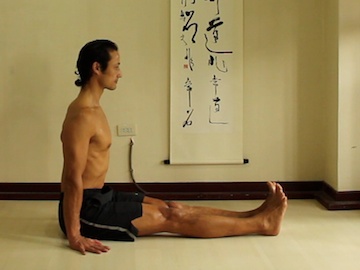
If the standing ashtanga yoga poses focused on stability, (at least that is one possible interpretation) the seated postures of the primary series focus on forward bending.
On page cat links

If the standing ashtanga yoga poses focused on stability, (at least that is one possible interpretation) the seated postures of the primary series focus on forward bending.
The Ashtanga Yoga seated series starts with a seated posture with your legs straight ahead. Following this are three forwards bends with both legs straight, each one going deeper than the next. Next is a reverse plank that acts as a counterpose, forcing you to exercise the back of your body where in the forwards bends you were stretching the back of your body.
The nine yoga postures that follow are all variations of forwards bends, mostly with one leg straight and the other leg bent.
If you look at each pose as a preparation for the next, then these first postures might all be a way of opening the back of your body so that it is easier to do navasana (boat pose) which involves activating the front of your body. From this point of view (activating the front body) you could consider boat pose to be the compliment of reverse plank (where you activated the back of the body).

The first pose is called dandasana or stick pose. You can use this pose to lengthen your spine and to push your legs forwards. If you focus on using your hips to push your legs forwards, you may be able to create space in your hip joint that may make it easier to bend forward.
Read about "creating space" in the hip joint.
With respect to your torso, reach your ribs upwards, away from your pelvis, and pull your head back and up, away from your ribcage. Rest your palms on the floor.
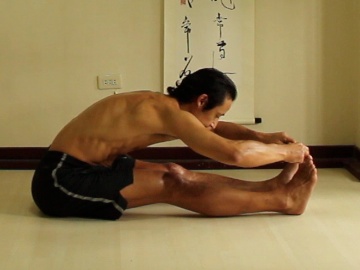
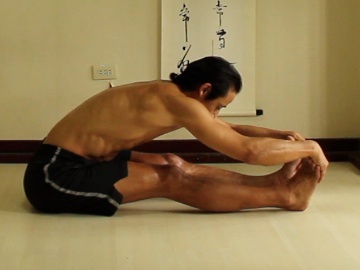
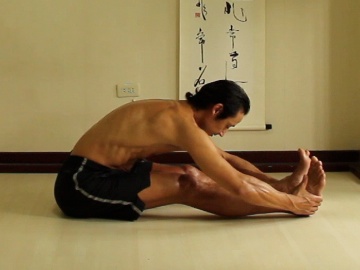
The four forward bends are called paschimottanasana (West Stretch or Seated Forward Bend) and are differentiated by calling them 1, 2, 3, 4 (or a, b, c and d). All four versions are done with the legs straight and together (or if you like, separated about hip width.)
You may find it helpful to press down with your legs and pull up with your arms while doing these forward bends. If that's too much, try being active while inhaling and relax the tension while exhaling.
When grabbing your toes you can press forwards through the ball mound of your big toe. You could also focus on keeping your back straight or even on bending your spine backwards.
Use your Spinal Erectors to do this.
Also focus on pressing the crown of your head away from your anus.
When grabbing the sides of your feet activate the edges of your feet. Tilt your pelvis forwards more for this variation. You can also begin to relax your spine slightly to give your arms more room to reach forwards.
For the final version (which I have trouble doing) reach your ribs and shoulders forwards to give yourself room to clasp a wrist beyond your feet. Once you have a wrist you can focus on relaxing downwards.
Hold each variation for five breaths.
To move from one pose to the next, inhale and look forwards, change your hand position and then exhale.
To leave the last position, inhale look forward, exhale sit up and to move to the next posture do a vinyasa.

To do Purvotanasana (East Stretch or Reverse Plank), sit upright with your hands on the floor behind you.
Push your hands forwards against the floor. Keep that tension as you lift up.
Push your heels down and your pelvis up. And lift and open your ribcage. If possilbe, touch the fronts of your feet to the floor.
Inhale up into the posture, hold for five breaths and come down with an exhale.
Do a vinyasa.
Remember that reverse plank is a complement to the forward bending series of paschimotanana.
The following postures are all asymetrical. (Up to Navasana that is!). Do the right side first and then the left.
How do you decide which side is the "right side." In this case it is the leg doing the action the posture is named after. So in half bound lotus forward bend the "right side" version of the pose is with the right leg in lotus. In half hero, right side is the one with the leg that is in hero pose. In the marichyasana series, right side is the leg that is in the marichyasana position.
Oh, I skipped the janusirsasana series. In those poses, the right side means bending the right knee.
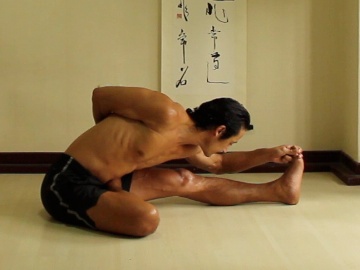
Back to task, the next posture after reverse plank is Half Bound Lotus forward bend. This is similiar to the standing version of the pose (Ardha Baddha Padmottanasana).
Place the center of the top of your right foot on the center line of your left thigh. Work at pulling the leg back so that your heel touches the left side of your lower belly. If it worked for you in the standing version, try squeezing your gluteus maximus and then release it. See if releasing helps you to get your leg deeper into the lotus position.
Bend forwards slightly and if you need to for the next stage, turn your ribcage to the right. Reach your right arm forwards to help open your shoulder, then reach your arm to the side, to the back and then wrap it behind your body to grab onto your right foot. Make your right foot strong so that you provide a firm foot for grabbing on to.
Slowly bend forward. You can grab your front foot with your free hand or place in on the floor.
If you aren't used to lotus, bend forwards slowly so that you can stop if you feel any pain in your knee.
Also, read Half Bound Lotus for detailed instructions and preparation postures for working towards getting your leg in lotus, binding (and bending forwards) in this pose.
Hold for five breaths. If you wish do a vinyasa or skip the vinyasa and then do the other side.
As with the forward bend, use your inhales to lengthen and relax on your exhales.
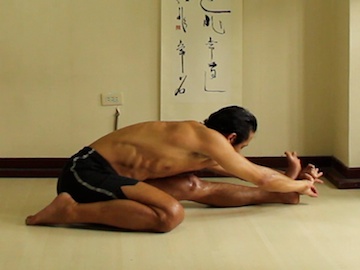
Triang Mukha Eka Pada Paschimottanasana is a mouth full. The name might refer to the triangle formed by your knees and your front foot.
To get into this yoga pose, fold your right shin back to the outside of your right thigh. Your right knee is beside your left knee. Try to position your right foot so that the top of your foot is on the floor.
While sitting reach your spine upwards. Push down with either the left side of your pelvis or your left heel. You may find that these actions help you to press your right hip down.
Try pulling (sucking) your right thigh into its hip socket. Try reaching your left thigh out of its hip socket. Keep these two actions and bend forwards. Use this two actions as anchors to help your pull your center of gravity to the right so that you right hip continues to sink down.
If you can balance, grab your foot or a wrist. If you can't then place your hands on the floor either side of your straight leg.
Hold each side for five breaths. Each inhale push your pelvis back and reach your ribs and head forwards. Relax on your exhales. If you wish , do a vinyasa between sides. Then do a vinyasa to enter the next set of postures called Janusirsasana.
Note that you can consider hero pose as a compliment or counter pose for the half lotus position. That may help you to remember to do this pose after the lotus pose.
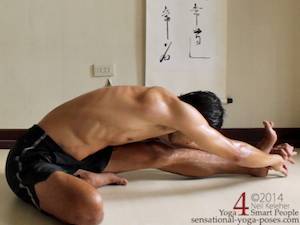
In the Janusirsasana postures, one knee is bent and presses down into the floor. The other leg is straight.
In Janusirsasana A, place the foot of your bent knee to the inside of your straight leg thigh.
Try to pull your heel as close to your groin as possible. See if you can position your pelvis at 90 degrees to your straight leg. For a slightly easier stretch open this angle up. For a deeper stretch try to position the straight leg foot directly in line with the center of your pelvis.
Inhale lengthen and grab onto your foot or a wrist. Exhale fold.
Do both sides in variation A, with a vinyasa inbetween if you wish, then move to variation B.
In Janusirsasana B you sit on your heel. More precisely you place your anus, or your perineum on top of your heel. Very comfortable. As with variation A, bend forwards.
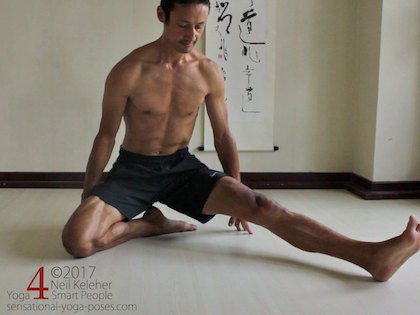
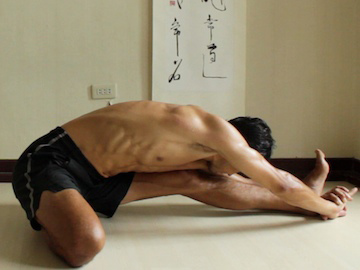
If your knee won't take the strain or you can't touch your butt to your heel, support your weight with your hands. Or place a block under one sitting bone.
Use a block high enough to make your knee comfortable but low enough that you lenghten the tendons at the front of the joint a little bit.
In Janusirsasana C you tuck your toes under and place the sole of your foot against your inner thigh with your heel up and the front of your foot down. Once you have your foot in position press your heel into your inner thigh and reach your knee to the floor.
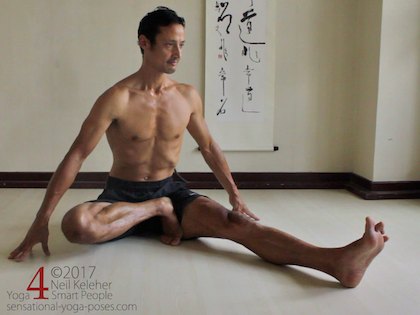
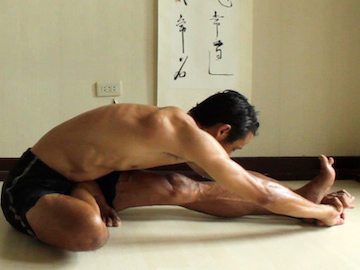
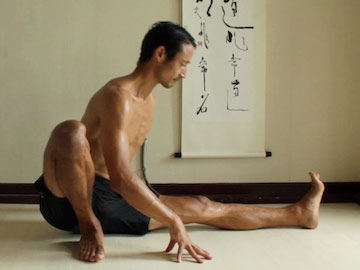
A variation is to place your foot on the floor and turn it out 90 degrees with your knee up, beside your shoulder (third picture.)
You could also kneel with both knees and then put one foot in the janu sirsasana C postion. (not shown.)
The next set of Ashtanga Yoga Poses are the four Marichyasana postures. The Marichyasana position is characterized by having the knee bent and the sole of the foot flat on the floor, like a half squat.
In Marichyasana A, place your right foot in the marichycasana position and have your left knee straight. 1. Reach forwards with your right arm inside your right leg. Try to get your shoulder past your shin. 2. Reach your right arm back outside your right leg. Bend your right elbow and grab your left hand behind your back. 3. Reach your chest forwards. Exhale.
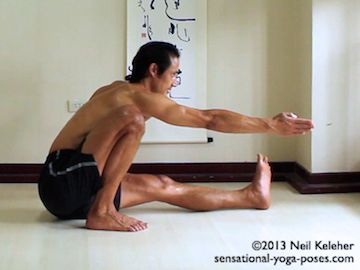
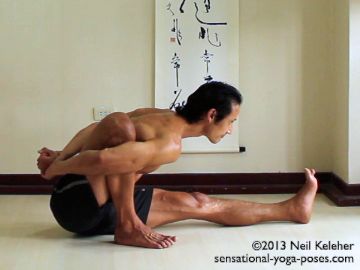
Once you are familiar with the pose, do step 1 with an inhale, step 2 with an exhale and step 3 with an inhale.
Hold for five breaths.
Do a special vinyasa (try lifting up and moving into Eka Pada Bakasana) or a normal one if you like and then do the other side.
Do a Special vinayasa or normal vinyasa and get ready for the B position.
In Marichyasana B, your right leg is in the marichyasana position but your left leg is in lotus. Put your left leg in lotus first and then position your right foot as required.
As with the A position, bend forwards (if your lotus knee allows) and "bind" your right leg.
Move slowly and smoothly and rather than forcing your way into the pose try to feel your way into it.
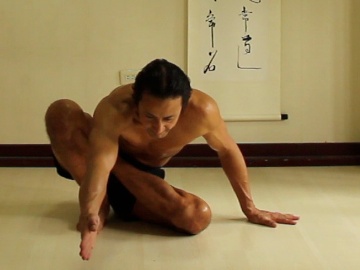
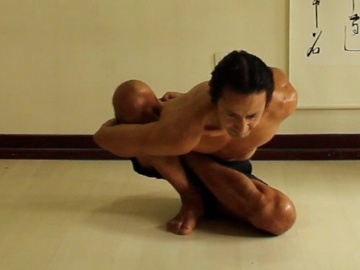
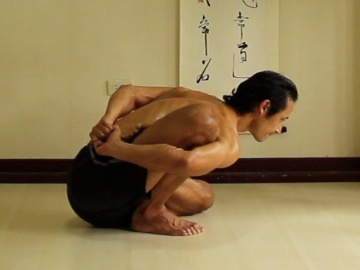
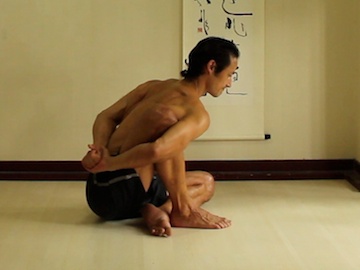
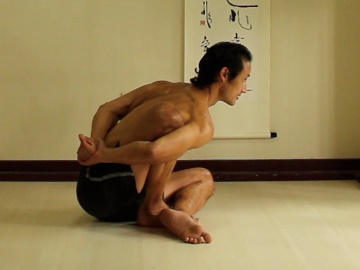
Optionally, have your "lotus" leg tucked behind your marichyasana foot, or in front of it.
Marichyasana C is simillar to A except that you twist towards the marichyasana leg. You also bind. To bind, try to get your left shoulder close to your right knee. Reach the upper part of your left arm down and across the outside of your right leg. Try to get your elbow past your shin. Once there, bend your elbow and try to grab your right wrist from behind your back. Bind your right leg.
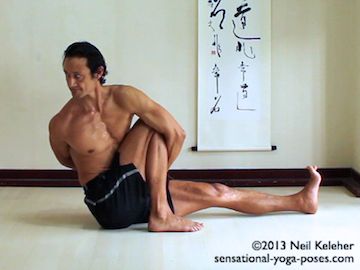
Once your have the bind focus on using your arms to turn and twist your ribcage relative to your pelvis.
Marichyasana D uses the same leg position as the B position. But as in C you twist towards the marichyasana leg.
For this version, try first to turn your pelvis in the opposite direction to your ribcage. This is to create more room in your marichyasa hip so that you can pull your knee to the left. Lift your lotus knee and try to pull it towards your center line so that you heel presses into your belly even more. Then try to bind as you did in the C position.
Move slowly and stop if your knee is giving your grief. From personal experience it isn't worth visiting the pose even once if the consequence is a messed up knee.
That being said, if you move slowly and smoothly you may just find your way into the pose.
Hold all Marichyasana variations for five breaths
In all of the marichyasana poses, the general rule of thumb for binding is the hand that wraps around the leg is the hand that grabs.
That being said, try the other option just to see how it feels. You could also try alternating grips to help you open your shoulders.
For the marichyasana series, remember to alternate straight leg with lotus variations. And remember that the two forward bending variations are before the two twisting variations.
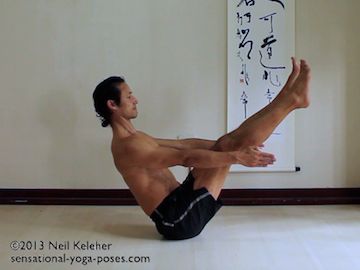
For some reason Navasana (Boat Pose or V-sit position) is done five times in a row without resting. You hold for five breaths, lift up, then do it again.
If you are tough, force yourself, if you are like me, work towards it. Do it with knees bent and focus on making your spine straight and your core strong. For best stability I'd suggest activating your obliques, the sides of your waist, rather than relying solely on your rectus abdominus.
From there work at making your front, back thigh muscle active. Squeeze knees and activate your feet. Activate everything. See if that makes the pose easier to hold.
While working towards doing all five sets of Navasana one after the other, I would suggest resting between sets.
Rest till you are ready to do the next one. And then while doing each set focus on maximum contraction to make your muscles strong.
Then gradually reduce your time resting inbetween poses.
Up to this point the forward bends have been "gravity assisted." You could think of navasana as a muscle assisted forward bend.
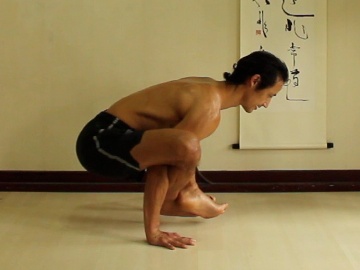

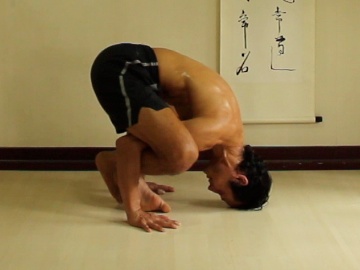
After your last navasana you do a vinyasa and then jump your legs around your arms. In mid air you cross your feet in front of you and then rest your forehead on the floor with your feet lifted. A good start is to sit down with your legs around your arms and then cross your ankles. From there you can work at crossing your ankles while lifted. And then from there work towards lifting your feet off of the floor while your head is on the floor. My feeling is that this prepares the way for kukktasana, so even if you can't lift your feet, do work at using your inner thighs to pull your legs upwards.
Like navasana, the previous pose, you have to pull inwards to do this pose. In navasana you tensed the belly. In this pose you squeeze the legs inwards, onto the arms.
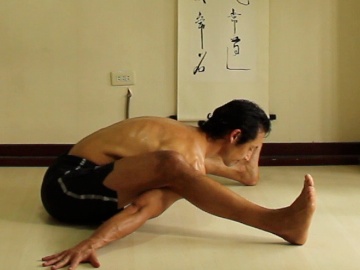
In kurmasana you straighten your legs on top of your arms. I'd suggest pushing your arms upwards against your legs and pushing your legs down, against your arms.
For both this pose and the last one you can lift up into firefly and then move into bakasana for the vinyasa.
This pose is challenging to do by yourself. From kurmasana you cross both ankles behind your head and grab your hands behind your back. There's a reason there's no picture of me doing it. I can't!
However, plenty of people can and to work towards it I'd suggest working on getting your foot behind your head one leg at a time while sitting upright or while reclining.
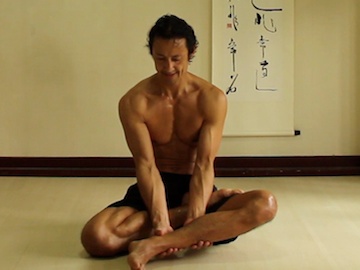
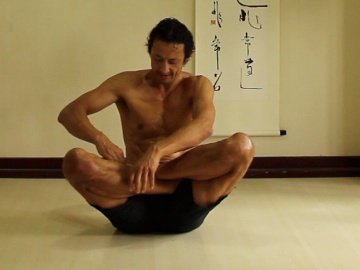
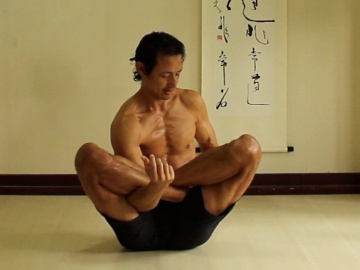
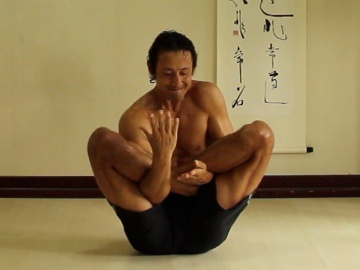
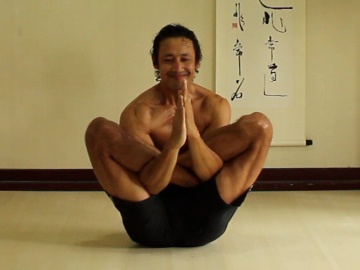
Garbha pidasana is fun if you can get your legs into lotus without hurting your knees.
Once your legs are in lotus, with your left leg on top push your right hand through the hole behind your knee. (What hole? You have to make it!)
One you get the knob of your elbow through, then work on your other arm. From there bring your legs in closer (remember what I said about garbha pidasana) and then try to grab your face. Or put your hands in prayer and smile because you made it. From here, round your back and roll back and forwards 9 times in a circle. Then roll up and balance on your hands into kukkatasana.
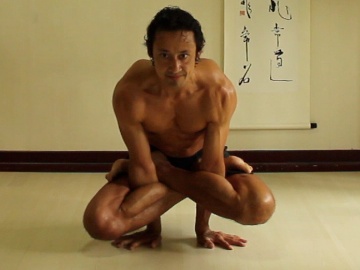
This can be tricky and dangerous it there is a table in front of you. Try to get up on to your hands from sitting. Once you can get the effort right for getting up onto your hands then try to roll up from when you are on your back.
Leno Miele apparently does Nauli Kriya while in this pose. At this point in time I have no clue how he does it.
Note that these three poses could be thought of as mirroring the Utthitta Padangusthasana (big toe pose) and ardha padmasana (half lotus forward bend) standing sequence of poses. The legs are first straight while opening the back of the hip (in kurmasana), and then the leg is folded in lotus (in kukkatasana).
